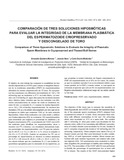Comparación de tres soluciones hiposmóticas para evaluar la integridad de la membrana plasmática del espermatozoide criopreservado y descongelado de toro
Résumé
El objetivo de este trabajo fue comparar la sensibilidad de tres medios hiposmóticos (HOST) para valorar la integridad funcional de la membrana plasmática (IFMP) de espermatozoides obtenidos de semen criopreservado de 12 toros. Se compararon tres soluciones con diferentes osmolaridades (0; 102 y 154 mOsm/Kg) que se incubaron a 37°C en baño María. La solución con 0 mOsm/kg (A: agua ultra pura) fue incubada durante cinco minutos (min), mientras que las dos restantes con diferentes concentraciones de cloruro de sodio se incubaron durante 30 min. La solución B y C constan de medios hiposmóticos a 102 y 154 mOsm/kg, respectivamente. Se tomaron tres muestras (100 µL) de semen descongelado por toro que se introdujeron en viales que contenían 1000 µL de cada solución hiposmótica. Sobre frotis realizados con cada medio y teñidos con Eosina-nigrosina (EN) se evaluaron 100 espermatozoides para determinar (en conjunto) el porcentaje de viabilidad y de
flagelos reaccionados (FR). La asociación del HOST con la EN fue realizada para identificar los espermatozoides vivos o muertos con FR o intactos. Los resultados demuestran mejores porcentajes de espermatozoides con FR para las soluciones B (49,75 ± 4,17) y C (56,33 ± 4,17) versus la solución A (32,16 ± 4,17) (P<0,05). Cuando se asociaron los FR con el porcentaje de supervivencia se observó la misma tendencia (A= 8,75 ± 1,56 versus B: 26,33 ± 3,46 y C: 29,41 ± 2,67). Estos valores indican que las condiciones B y C son medios hiposmóticos apropiados para la valoración de los espermios, ya que propician la torsión helicoidal del flagelo manteniendo la IFMP del espermatozoide en el 52% de los casos. Se concluye que la condición osmolar A no se recomienda debido a que causa pérdida de la IFMP y muerte celular, lo cual quedó en evidencia al apreciar que solo un 8% de espermatozoides con flagelos reaccionados sobreviven luego del un estrés osmótico tan bajo.
Colecciones
Información Adicional
| Otros Títulos | Comparison of three hyposmotic solutions to evaluate the integrity of plasmatic sperm membrane in cryopreserved and thawed bull semen |
| Correo Electrónico | armando.quintero@fcv.luz.edu.ve |
| ISSN | 0798-2259 |
| Resumen en otro Idioma | The objective of this study was to compare the sensitivity of three hyposmotic test (HOST) to evaluate the functional integrity of the plasmatic sperm membrane (IFMP) obtained from cryopreserved semen of 12 bulls. Were compared three solutions with different osmolarities (0,102 and 154 mOsm/kg) which were incubated at 37°C in a water bath. The solution with 0 mOsm/kg (A: ultra pure water) was incubated for five minutes (min), while of two remaining with different concentrations of sodium chloride were incubated for 30 min. Solution B and C comprise a hyposmotic media at 102 mOsm/kg and 154 mOsm/kg, respectively. Three samples were taken (100 µL) of thawed semen per bull, that were Introduced in vials containing 1000 µL of each hyposmotic solution. About smears performed with each medium hyposmotic and stained with eosin and nigrosin (EN), 100 spermatozoa were evaluated to determine (together) the percentages of viability and swelling flagellas (FR). The association of the HOST with EN was performed to identify the percentage of spermatozoas live or dead with FR or intacts. The results of the HOST demonstrated higher percentages of spermatozoes with FR for treatments B (49.75 ± 4.17) and C (56.33 ± 4.17) versus treatment A (32.16 ± 4.17) (P<0.05). These values indicate that the conditions B and C are optimal solutions, propitiating the helical twist of the flagellum, maintaining the IFMP of the sperm in 52% of cases. The osmolar condition A is not recommended because it causes loss of IFMP and cell death, thus was in evidence to appreciate that only 8% of sperm with flagella reacted survive after osmotic stress as low. |
| Colación | 489-495 |
| País | Venezuela |
| Institución | Universidad del Zulia (LUZ) Universidad de Los Andes (ULA) |
| Publicación Electrónica | Revista Científica |
| Sección | Revista Científica: Medicina Veterinaria / Veterinary Medicine |






